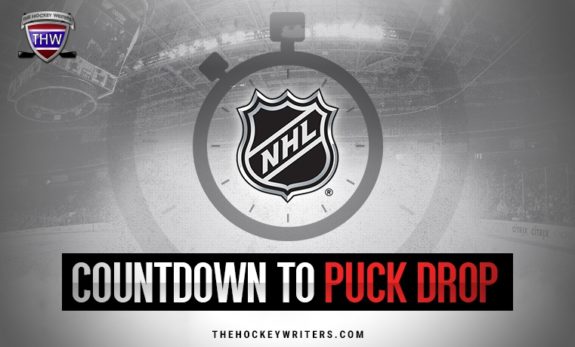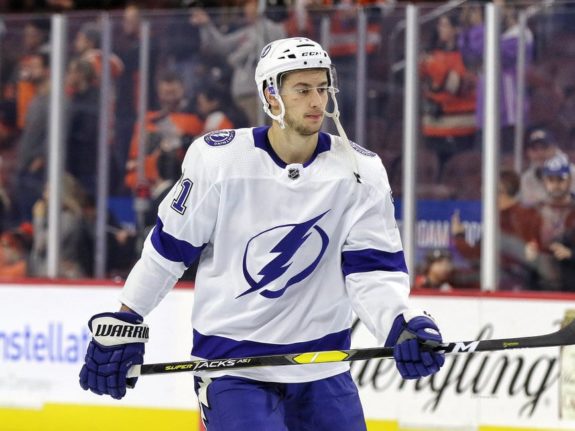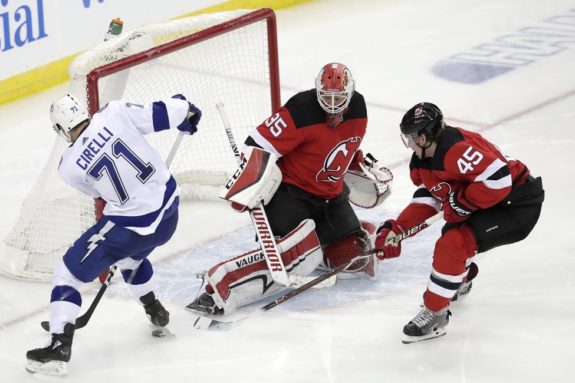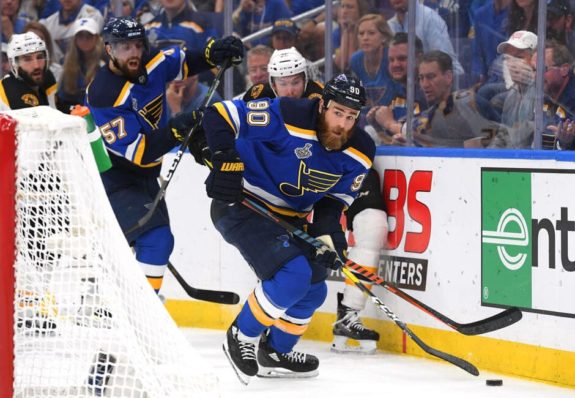Introducing The Hockey Writers’ Countdown to Puck Drop series. From now until the puck drops on the 2019-20 NHL’s regular season on Oct. 2 when the Toronto Maple Leafs host the Ottawa Senators, we’ll be producing content that’s connected to the number of days remaining on that particular day. Some posts may be associated with a player’s number, while others will be connected to a year or length of time. We’re really excited about this series as we take you through the remainder of summer in anticipation of the return of NHL hockey.

With 71 days left until puck drop, here’s a look at the Tampa Bay Lightning’s No. 71 Anthony Cirelli and why he could one day be a Frank J. Selke Trophy nominee.
Developing Quickly
Cirelli broke onto the scene in March 2018 to help the Lightning with their playoff push. In his first NHL game, he netted his first NHL goal with a short-side snipe on former Lightning goaltender Ben Bishop. Tampa Bay fans expected that kind of speed and explosiveness from forwards like Steven Stamkos and Nikita Kucherov, but not Cirelli. Fans quickly became familiar with the then-21-year-old as he had 11 points in 18 regular-season games and became one of the team’s top penalty killers at the end of the season.

In 2018-19, Cirelli picked up right where he left off by scoring the Lightning’s first goal of the season shorthanded. He increased his average time-on-ice by more than a minute from 2017-18 and proved to be one of the best two-way players in the organization throughout last season. He also became a strong center in the face-off dot, something the Lightning have struggled with historically. He won just 44.9% of his face-offs in 2017-18, but last season, he increased that number to 52.8%.
Related: Three Superbly Underrated Lightning Players
Cirelli developed about as quickly as any player could in the NHL and he became an essential part of the NHL lineup almost overnight. Without a strong two-way, penalty-killing forward like Cirelli, the Lightning wouldn’t have led the league in penalty killing.
Becoming a Penalty Killer
Last season was still technically Cirelli’s rookie season, and he was voted to the NHL All-Rookie team having played all 82 games and, more importantly, was second in the NHL in shorthanded goals. Just under 70% of his ice time takes place in the Lightning defensive zone, up by about 13% from 2017-18, which shows how strong he was on the kill.
One statistic that makes Cirelli an elite penalty killer is his giveaways and takeaways. When the Lightning were shorthanded, he had only one giveaway in 219 total minutes, but he had 13 takeaways. What this shows is his ability to get sticks in the passing lanes and to read the opposition and predict what’s going to happen next. He also won 52% of his face-offs while shorthanded which allowed the team to possess the puck and kill off penalties more efficiently.

For good measure, Cirelli led all Lightning forwards in shorthanded time-on-ice with 2:55 per game, but he also led all forwards in the league in shorthanded ice time with his 219 total minutes. He had more time shorthanded than Norris Trophy-winning defenseman Mark Giordano, John Carlson and Drew Doughty for starters. Not too shabby for a 21-year-old rookie.
Compared to the Selke Winner
St. Louis Blues forward Ryan O’Reilly won the Selke Trophy this year and comparing his numbers with Cirelli’s creates an interesting conversation. Obviously, O’Reilly has more playing time on the Blues’ top line and scored more often because of that, but they both played 82 games and Cirelli had two more points than O’Reilly while shorthanded. He also had 94 takeaways and 33 giveaways, while Cirelli had 46 takeaways and 15 giveaways while playing nearly 500 total minutes less.
Last season, Cirelli won 52.8% last year which is nearly identical to O’Reilly’s face-off percentage in his age-21 season. Cirelli’s shorthanded face-off percentage last season was just 0.1% below the Selke winner. The Blues center is known for his face-off ability and the Lightning should be very encouraged to see his numbers so close to someone with the face-off prowess like O’Reilly.

The difference between O’Reilly and Cirelli have to do with their roles on their respective teams. O’Reilly has always been a first- or second-line center who can score 50 or more points a season. Cirelli, on the other hand, is a third-line center on a Lightning team who has elite players on their first and second lines. But, he could definitely slot into a second or even first-line role if the Lightning were desperate for centers. O’Reilly has the edge in point-scoring, but they are very comparable in many key statistics for Selke Trophy voting, especially as mainstays on the penalty kill.
As a rookie last season, Cirelli finished sixth in Calder Trophy voting for the league’s top rookie and 11th for the Selke Trophy. As a 21-year-old, he has a lot of time to develop both on and off the ice, and it helps that he plays with some of the top forwards in the league as well as a few of the best defensemen. He can learn from all of those players to continue to be a threat on both sides of the puck en route to one day winning the Selke Trophy.